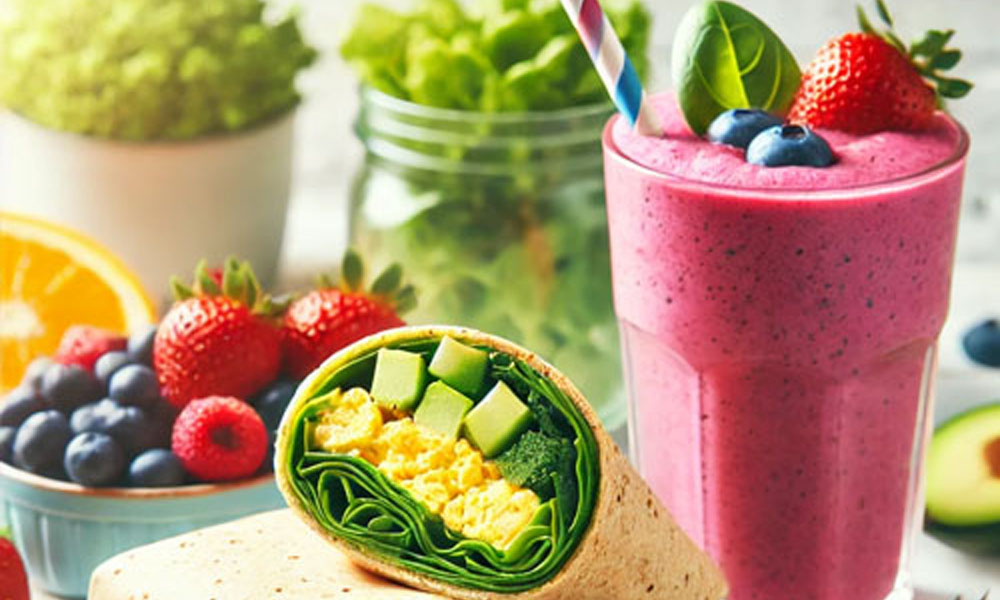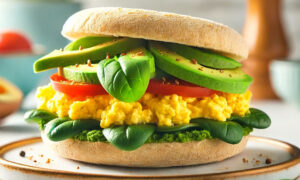Pancakes, eggs, hash browns, and sausage are the common ingredients associated with most breakfast platters. This platter can sometimes be 1,000-1,500 calories. Once you consume a platter with this many calories, you’re halfway to the recommended amount of calories that an adult should consume every day.
Being halfway to the recommended point of your daily calorie intake can cause you to gain unwanted weight. It can also hinder you from losing unwanted weight. These breakfast platters are full of empty calories that starve your body of nutrition, sounds like a conundrum, doesn’t it?
With this complex issue of eating breakfast on the go, “healthy eating” almost seems impossible. You can actually improve a breakfast for yourself by incorporating some simple eating tips
Solution: Crafting a Healthier Breakfast Plate
For one, to reduce the calorie intake of any breakfast platter, you should skip the pork sausage and opt for a beef or chicken sausage, a veggie patty, or tofu. If your tastes are not towards any of those options, you can increase the egg portion of your meal and eliminate the meat or meat substitutes altogether.
To minimize the refined sugar intake sometimes fast food restaurants can or will serve salad or a no-sugar version of their syrups. You can also order fresh fruit and make water your choice of drink to help improve the flow of the digestion of your food.
Variety in Your Breakfast Plate: A Healthier Alternative Approach
Consider diversifying your breakfast plate to create a healthier alternative. Your platter can look something like this:
- Pancakes, eggs (no cheese), fruit, and water.
- Pancakes, eggs, hash browns, fruit, water.
- Pancakes, beef or chicken sausage, fruit, water.
- Double eggs, hash browns, fruit, water, or orange juice.
- Hash browns, beef or chicken sausage, fruit, water, or orange juice.
The key is to maintain balance by consuming a fair amount of bread, protein, sugar, and fat. If you choose a sweet option like pancakes, try not to pair it with something too salty, such as meat. Conversely, if you opt for something salty like hash browns or meat, dilute it with water and avoid adding additional sugar on top of the sodium.
Navigating Fast Food: Seeking the Best and Healthiest Options
If you’re traveling, it’s a good idea to set your phone to the local currency so that all of your transactions are automatically labeled with their correct prices.
Fiddling around with exchange rates all the time is not worth it!
Book flights on Tuesdays and Wednesdays to get the cheapest fares
Eating healthy on the go can be a beautiful symphony of eating for a healthier body, a rhythmic consumption that can improve your overall health.
When considering fast food options, explore the best and healthiest choices available. Look for low-calorie meals and heart-healthy alternatives to make informed decisions about your fast-food consumption.
Use Google Maps offline so you can still navigate even without a connection
If you’re driving or walking between places and don’t have a data connection, use Google Maps’ offline mode. It’ll still give you directions and useful information like the distance to your destination, what streets to take, and how long it’ll take to get there.
You can also download a map of your places of interest ahead of time, and then you get to use it anywhere – even on things like subways!
Conclusion: Starting the Journey to Healthy Eating
Eating healthy is a simple method of choosing how to eat. Considering the best and healthiest fast food options can be a great start, especially when looking for fast food low-calorie meals.
Opting for fast food heart-healthy choices and exploring fast food healthy alternatives can contribute to a balanced and nutritious diet. We all have to start somewhere on our journey to better eating habits.




